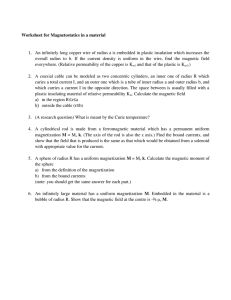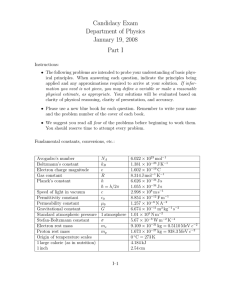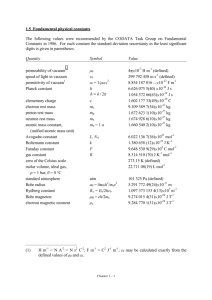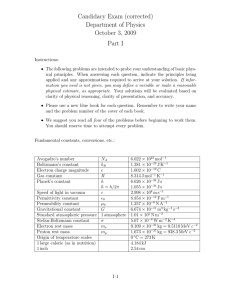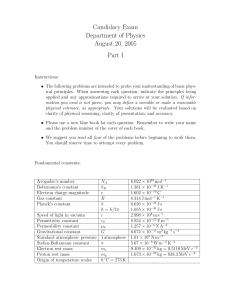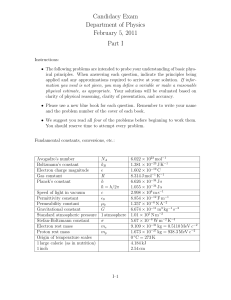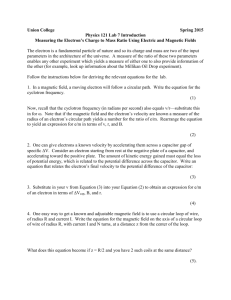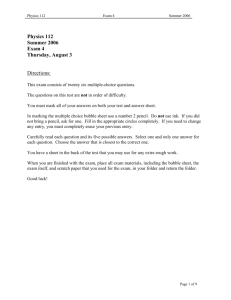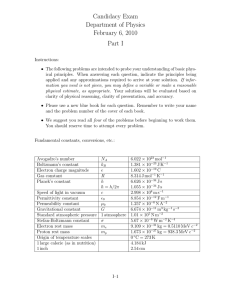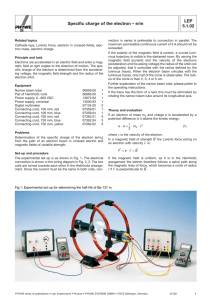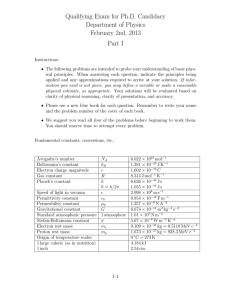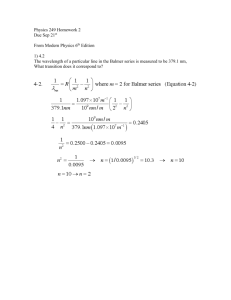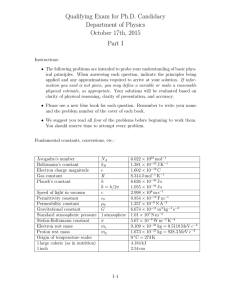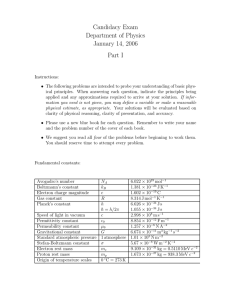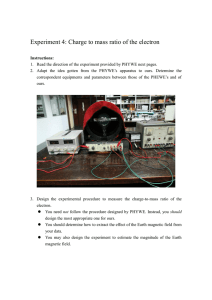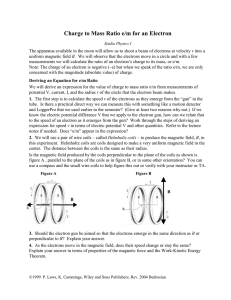Candidacy Exam Department of Physics August 26, 2006 Part I
advertisement
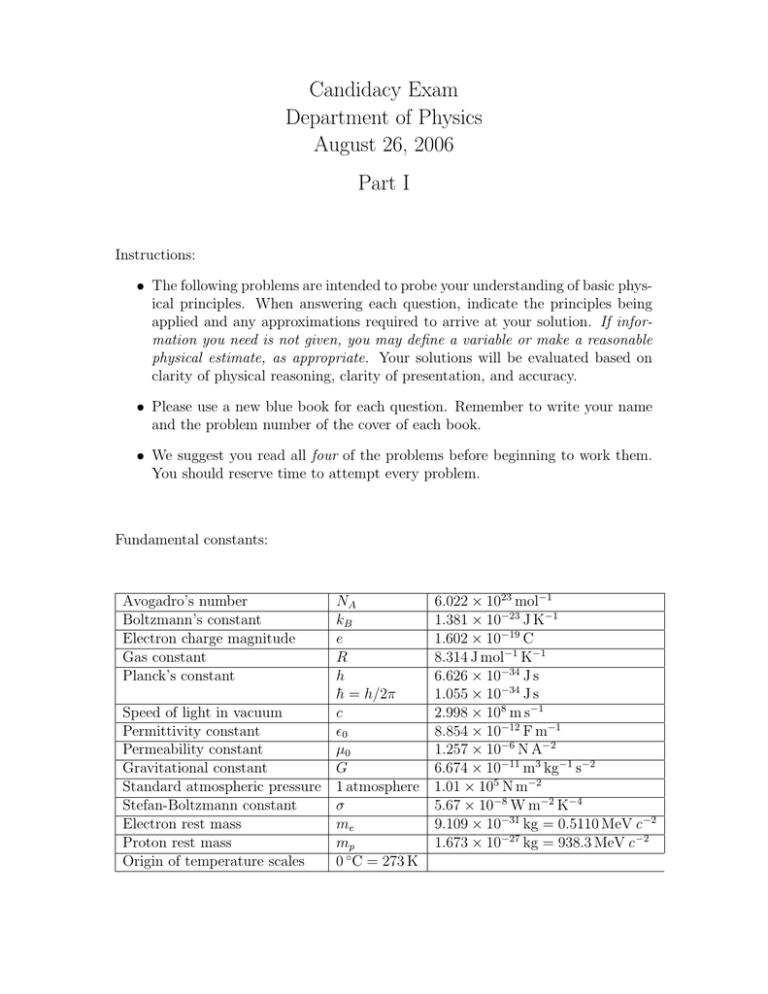
Candidacy Exam Department of Physics August 26, 2006 Part I Instructions: The following problems are intended to probe your understanding of basic physical principles. When answering each question, indicate the principles being applied and any approximations required to arrive at your solution. If information you need is not given, you may define a variable or make a reasonable physical estimate, as appropriate. Your solutions will be evaluated based on clarity of physical reasoning, clarity of presentation, and accuracy. Please use a new blue book for each question. Remember to write your name and the problem number of the cover of each book. We suggest you read all four of the problems before beginning to work them. You should reserve time to attempt every problem. Fundamental constants: Avogadro’s number Boltzmann’s constant Electron charge magnitude Gas constant Planck’s constant NA kB e R h h̄ = h/2π Speed of light in vacuum c Permittivity constant 0 Permeability constant µ0 Gravitational constant G Standard atmospheric pressure 1 atmosphere Stefan-Boltzmann constant σ Electron rest mass me Proton rest mass mp Origin of temperature scales 0 ◦ C = 273 K 6.022 × 1023 mol−1 1.381 × 10−23 J K−1 1.602 × 10−19 C 8.314 J mol−1 K−1 6.626 × 10−34 J s 1.055 × 10−34 J s 2.998 × 108 m s−1 8.854 × 10−12 F m−1 1.257 × 10−6 N A−2 6.674 × 10−11 m3 kg−1 s−2 1.01 × 105 N m−2 5.67 × 10−8 W m−2 K−4 9.109 × 10−31 kg = 0.5110 MeV c −2 1.673 × 10−27 kg = 938.3 MeV c −2 I–1. A particle of mass m moves in a plane under the influence of a central attractive force K F = − 2 e−µr , r where K and µ are constants. (a) Obtain an equation for the time dependence of r, the distance of the particle from the center of attraction. (b) Determine the condition(s) on the constants such that circular motion of constant radius R is stable. (c) Compute the frequency of small radial oscillations about this circular motion. I–2. A hollow cylinder of inner radius a, outer radius b, and height h has a resistivity of ρ. What is the resistance R = (Vb − Va )/I for a current flowing from the outer to the inner radius. b a h I–3. The wave function of an electron in p a one-dimensional p infinite square well at time t = 0 is given by Ψ(x, 0) = 2/5ψ1 (x) + 3/5ψ2 (x), where ψ1 (x) and ψ2 (x) are wave functions for the ground state and first excited stationary states of the system. [The well, of p width a, extends from x = 0 to x = a, the energy eigenfunctions are ψn (x) = 2/a sin(nπx/a), and the eigenenergies are En = n2 π 2 h̄2 /(2ma2 ), where n = 1, 2, 3, . . ..] (a) Write down the wave function Ψ(x, t) at time t in terms of ψ1 (x) and ψ2 (x). (b) You measure the energy of an electron at time t = 0. Write down the possible values of the energy and the probability of measuring each. (c) Calculate the expectation value of the energy in the state Ψ(x, t) above. I–1 I–4. Consider a collection of N independent particles, each bearing a magnetic moment µ which may be direction either up or down. Define n by saying that the number of spin-up moments is (N + n)/2, and the number of spindown moments is (N − n)/2. The net magnetization is therefore M = µn. Assuming that there is no external magnetic field and that N is a very large number, derive the probability distribution W (n) for having the magnetization M = nµ. Derive the average value of the magentization, hM i, and the average value of the squared magnetization, hM 2 i. Hint: Stirling’s approximation may be useful: ln N ! ' N ln N − N for large N . I–2 Candidacy Exam Department of Physics August 26, 2006 Part II Instructions: The following problems are intended to probe your understanding of basic physical principles. When answering each question, indicate the principles being applied and any approximations required to arrive at your solution. If information you need is not given, you may define a variable or make a reasonable physical estimate, as appropriate. Your solutions will be evaluated based on clarity of physical reasoning, clarity of presentation, and accuracy. Please use a new blue book for each question. Remember to write your name and the problem number of the cover of each book. We suggest you read all four of the problems before beginning to work them. You should reserve time to attempt every problem. Fundamental constants: Avogadro’s number Boltzmann’s constant Electron charge magnitude Gas constant Planck’s constant NA kB e R h h̄ = h/2π Speed of light in vacuum c Permittivity constant 0 Permeability constant µ0 Gravitational constant G Standard atmospheric pressure 1 atmosphere Stefan-Boltzmann constant σ Electron rest mass me Proton rest mass mp Origin of temperature scales 0 ◦ C = 273 K 6.022 × 1023 mol−1 1.381 × 10−23 J K−1 1.602 × 10−19 C 8.314 J mol−1 K−1 6.626 × 10−34 J s 1.055 × 10−34 J s 2.998 × 108 m s−1 8.854 × 10−12 F m−1 1.257 × 10−6 N A−2 6.674 × 10−11 m3 kg−1 s−2 1.01 × 105 N m−2 5.67 × 10−8 W m−2 K−4 9.109 × 10−31 kg = 0.5110 MeV c −2 1.673 × 10−27 kg = 938.3 MeV c −2 II–1. (a) State and prove the parallel axes theorem, which relates the moment of inertia of an object about an arbitrary axis to the moment of inertia about a parallel axis through the object’s center of mass. (b) A rigid loop of wire has radius R and is suspended from a frictionless pivot at its edge. Find the period of small oscillations under gravity. Neglect the radius of the wire and of the hook relative to R. R II–2. A magnetic field is generated by two coaxial plane coils, each of n = 20 turns of radius a = 100 mm, separated by distance a. (a) Calculate the magnetic field at a point midway between the coils when a current I = 2 A flows in each coil. The current in the two coils is parallel. (b) Sketch the profile of the magnetic field strength summed along the axis of both coils. II–3. (a) A spin- 21 particle is in the presence of an external magnetic field applied in the z-direction, so that the relevant Hamiltonian is H = −BSz . (II–1) Which, if any, of the following are conserved quantities for this Hamiltonian: S 2 , Sx , Sy , Sz ? (b) The normalized spin state of the particle at t = 0 is given by |Ψ(t = 0)i = a |↑i + b |↓i, where |↑i and |↓i represent spin states with, respectively, spin parallel to and opposite to the z-axis, respectively. The coefficients a and b are real numbers that are arbitrary except for the normalization constraint. Calculate the expectation values at time t of (i) Sz and (ii) Sx . II–1 II–4. The equilibrium separation between hydrogen atoms in molecular H2 is 0.08 nm, and the force constant of the bond is 580 Nm−1 . (a) Estimate the minimum energy (in Joules) to cause each molecule to (i) rotate, (ii) vibrate. (b) Roughly sketch the dependence on temperature of the specific heat capacity of hydrogen gas between 30 K and 1000 K. II–2
